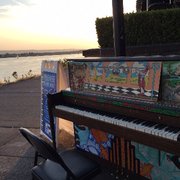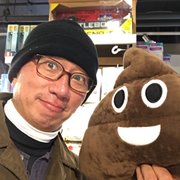“ If you like "firsts", and you like crowds, then you'll like Lin Heung Tea House, the oldest "yum chai" ("to drink tea") eatery in Hong Kong - so I guess that means, it's the first and oldest yum chai tea house in the world. In truth, Lin Heung Tea House was at least the oldest still existing yum chai eatery in the Guangzhou Province of China, opening in 1889 in central Hong Kong. Its original shop in China is still there, and we went to it. The Yan family is the current owner and operator of Hong Kong Lin Heung, and they have owned it for generations. But how did I get here? I came here first in the late summer of 1985, when my mother insisted on hauling my 26 year old butt to China, after she visited Epcot with my niece, and saw the panoramic Guilin exhibition at Epcot's Chinese Pavilion - and she became inspired. I had been to Europe a number of times by then, twice with my parents and twice with my friends. But this was my first trip to Asia, and it was sure great that my mother was footing the bill. We began our adventure in Japan, flying then to China for a four week tour of the PRC, which ended up in Hong Kong for our final week. And believe me, after 33 days in the Peoples Republic of Communist China moments after the death of Chairman Mao, where everyone dressed the same, and there were nothing but bicycles on the streets, I was overjoyed to finally land in a city that had cars, electric lights, and a decent Health Care System. Our fellow tourists, including our Canadian guide, were so overjoyed to be out of the Peoples Republic, with its pigs ears for breakfast and its hacked up fish with bones, that all they wanted in this hundred year old British Colony was to get a pile of cheeseburgers and crawl into their air conditioned hotel room to watch some English language Television. But not me, or my mom. While everybody else on the tour raced off as fast as they could to the nearest McDonald's, my mother and I took a taxi to the oldest Dim Sum place in Hong Kong, Lin Heung Tea House. Up a long flight of red ceramic stairs was one of the most crowded and loud restaurants I have ever been to. The energy in the room was electrifying. As each jam packed steamer cart emerged from the kitchen, customers leapt from their chairs, pushing their way to it waving their dim sum count slip above their heads, quacking loudly in high pitched Cantonese. It reminded me of traders trying to buy stocks at the Chicago Mercantile Exchange, or a neck to neck horse race. They descended on the cart like birds of prey, and in moments the cart was empty. This happened over and over again with each cart that emerged. And nobody seemed bothered by the noise or the running and the pushing; not even the aged women who were pushing the carts. In fact, everybody appeared to be enjoying themselves. It took a while for my mother and me to be seated, but when we finally were, our own horse race began. I leapt out of the starting gate like a crazy person and descended on the nearest cart as if I had been doing it all of my life. And it was delicious: cheap and delicious. And I got a free workout to boot. HERE'S SOME HISTORY AND FACTS ABOUT DIM SUM (not written by me) During the Qing Dynasty (1644 - 1911), people would stop by small houses to catch-up with each other and drink tea. In Cantonese, drinking is "yum" , and tea is "cha". There weren't many tables, just benches and seats where people could rest for a moment. "Tea", written茶, is pronounced chá in Mandarin and Cantonese, but te in the dialect of Southern Fujian Province and Taiwan. What is yum cha called in USA? Literally meaning 'drink tea' in Cantonese, yum cha is as common a meal in Hong Kong as coffee and toast in Western culture, where Chinese tea is enjoyed with dim sum at traditional tea houses. The world's oldest tea remains have been dated to 453BC-410BC in China in a new study by archaeologists from Shandong University and scientists from the University of Science and Technology Beijing. The 2,400-year-old remains of tea leaves were discovered in a royal tomb in Zoucheng, Shandong province Unsurprisingly China is top of the charts as the spiritual home of the humble cuppa and tops the list as the world's largest tea producing country. China produces some 40% of the world's tea weighing in at 2.4 million tons. ”







